The flag
When Victoria and other Australian colonies put their warships to sea in the 1800s, their navies needed to show their own “national flags”. The colony of Victoria developed its own flag after Britain’s Secretary of State for the colonies wrote letters in 1865, which required all colonial vessels of war to wear the British blue ensign, with the seal or badge of the colony on the fly. In February 1870, the then Governor of Victoria, the Honourable Sir John Henry Thomas Manners‑Sutton, proclaimed that the colony’s badge design on the flag would show the Southern Cross with 5 white stars.
From 12 November 1877, the badge was changed to include a Royal Crown to top the Southern Cross. In 1901, with the accession of Edward VII, this Crown was replaced with the Crown of St Edward and the flag has not changed since.
The Argus newspaper reported the first flying of the flag on one of the colony’s first warships, HMVS Nelson.
The white stars on the Victorian flag have differing sizes and numbers of points (from 5 to 8), to signify the brilliance of each star in the constellation of the Southern Cross and their varying brightness.
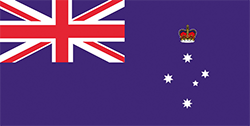
The Coat of Arms
From 1870, the 5 stars of the Southern Cross appeared on Victoria’s colonial badge. In 1877, a Royal Crown was added to the badge to top the Southern Cross to align the Coat of Arms badge with the Victorian flag badge. In June 1910, Victoria was granted its Coat of Arms by Royal Warrant.
The shield is blue with the 5 stars of the Southern Cross. Its supporters are 2 female figures named Peace and Prosperity, the state’s motto.
The state’s floral emblem, common pink heath, was added to the Coat of Arms in 1958 and grows from a grassy mound under the shield. Above the shield is a wreath of silver and blue, and the torso of a kangaroo holding the Royal Crown. The design of the Crown was changed from the Imperial Crown to St Edward’s Crown in 1973.
The colour references are:
- Blue: PANTONE® 541, and
- Silver: PANTONE® 877.
These are also the state colours.
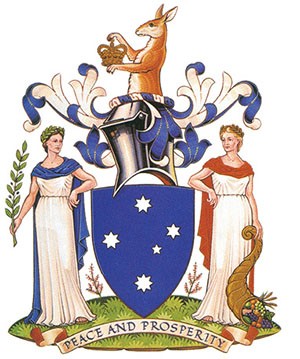
Motto on Arms
“Peace and Prosperity.”
On the Victorian Coat of Arms, Prosperity holds a horn of plenty (cornucopia) to symbolise rich harvests and she wears a circlet of golden cereal. Peace holds a symbol of peace, the olive branch.
The badge
The badge of Victoria is taken from the Victorian flag and the Victorian Coat of Arms. The colour reference for the shield is:
- Blue: PANTONE® 541.
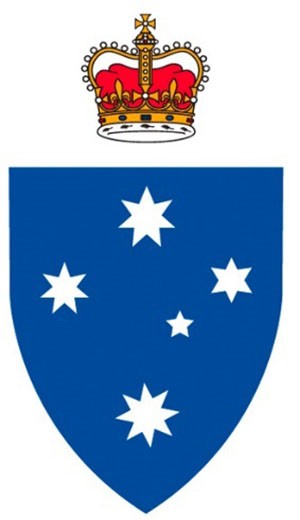
The floral emblem
Common pink heath
Imagine small, slender bushes tipped in tiny, bell-like pink flowers all pointing in the same direction and attracting little birds which hover like mini-helicopters to sip their nectar. It’s the common pink heath which was adopted in 1958 as the floral emblem of the state of Victoria.
The common pink heath actually comes in scarlet, crimson, rose pink and white - the pink variety is Victoria’s emblem.
Heath bushes are visited in winter and spring by the eastern spinebill, which hovers in front of the flowers for their nectar and returns the favour by pollinating the plants.
The common pink heath is a great survivor. It copes with frosts and is found mainly in southern Victoria’s semi-shaded wet foothills, coastal heathlands and in the scrub of the Little Desert. It grows from sea level to 1,200 metres and is also found in New South Wales, South Australia and Tasmania.
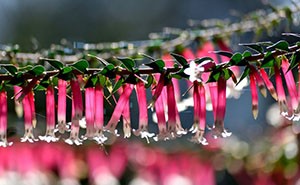
The animal emblems
The helmeted honeyeater
Victoria chose one of its rarest birds, the helmeted honeyeater, as its state emblem in 1971. Though seen by few people, the helmeted honeyeater would be hard to mistake with its tufted crown of downy gold feathers which project right over its bill, like a helmet.
The body of the helmeted honeyeater is olive-grey, with the outer wing and tail feathers turning greenish-yellow. Its underparts are yellow-green with dark streaks.
The sides of the head are glossy black with golden ear tufts and a yellow throat. It is 20 centimetres long and lays 2 pink, spotted eggs in a cupped nest from spring to summer.
The honeyeater can only be found in southern Victoria.
Yellingbo State Wildlife Reserve was set aside to protect colonies of the birds at a time when just 100 to 150 birds remained. The Reserve is on Woori Yallock Creek near Yellingbo, on the outskirts of Melbourne. Helmeted honeyeaters need a combination of manna and swamp gums, with tea-trees and shrubby bushes alongside grass-lined watercourses to provide a suitable natural habitat.
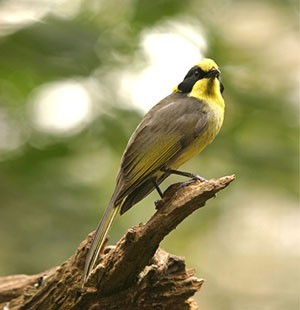
Leadbeater’s possum
The leadbeater’s possum became one of Victoria’s faunal emblems in 1971. Once feared extinct, the leadbeater’s possum lives in the great mountain ash forests of Victoria’s central highlands. They were rediscovered near Marysville in 1961 and are now known to range over a large area.
These nimble little possums, whose tails can be longer than their bodies, jump from branch to branch searching for insects on the leaves and under the bark, and eating nectar, insect honey-dew, sap and gum. Unlike other possums of their size, they do not have any gliding membrane between their legs.
Covered in soft grey-brown fur, these possums have beautifully marked faces and large, black eyes. A leadbeater’s possum is about 40 centimetres long from its nose to the end of its furry, dub-shaped tail.
The possum’s future depends on preservation of its natural habitat in the hardwood forests. The leadbeater’s possum is found in population pockets, particularly where there are old growth trees with hollows to provide sites for nesting.
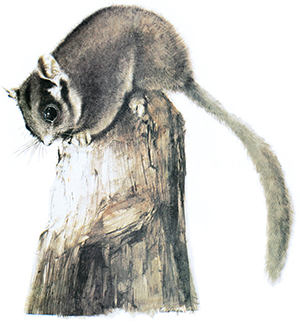
The state mineral
Gold
Victoria is the second largest gold producer in Australia. Gold was first discovered in Victoria in 1850.
The Victorian gold rush started when it was discovered in Ballarat in 1851. This led to mass immigration, wealth and development in Victoria. At its peak, up to 2 tonnes of gold per week flowed into the Treasury Building in Melbourne.
Victoria is known for giant masses of gold, referred to as nuggets. The most famous nugget found in Victoria is the Welcome Stranger. Discovered in 1869, it had a calculated weight of over 62 kilograms. It was the largest discovered alluvial gold nugget in the world.
Throughout history, gold has always been a valuable and sought-after precious metal. Its uses include coins, jewellery and other arts. It also has many practical uses in dentistry, electronics and other fields.
In 2012, both Houses of Parliament recommended that gold be the first mineral emblem of Victoria.
The state fossil
Koolasuchus cleelandi
Koolasuchus cleelandi is a 125 million year old extinct amphibian.
It was about the size of a car (3 to 4 metres long) that lived alongside dinosaurs in Victoria during the Cretaceous period.
Resembling something between a huge salamander and a crocodile, Koolasuchus cleelandi had dozens of ridged fangs and 2-inch tusks growing from the roof of its mouth. It lived in the rushing rivers that separated Australia and Antarctica, and fed on small dinosaurs, fish and turtles.
The fossil was found in 1978 near San Remo on Bunurong Country and is on permanent display at Melbourne Museum. Fossils of Koolasuchus cleelandi have only been found at beaches and coves in South Gippsland.
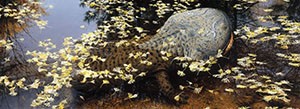
For further information on the symbols of Victoria, and for permission to reproduce the state Coat of Arms, please contact:
Strategic Communication,
Engagement and Protocol Branch
Protocol and Events
Department of Premier and Cabinet
1 Treasury Place
Melbourne VIC 3000
Phone: 1300 336 356
Email: protocol.enquiries@dpc.vic.gov.au
Other symbols may be used without seeking permission, but it is recommended that guidance on their proper use be sought from the address above.
For further information on the state’s emblems, please visit www.vic.gov.au/government-events-and-protocol.
